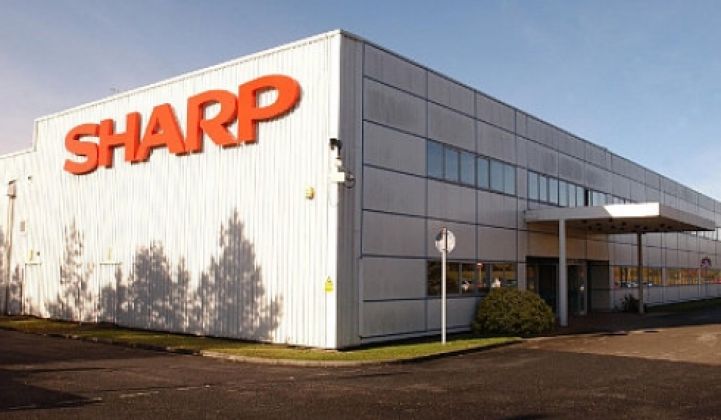California, already the epicenter of distributed solar PV, is also a growth market for behind-the-meter energy storage. Companies like Stem, Green Charge Networks, Coda and the dynamic duo of SolarCity and Tesla are installing big batteries in buildings, mainly on the business case of reducing demand charges for commercial and industrial customers.
In the future, those batteries could also help store, stabilize and shift solar power -- if the mechanisms and markets for paying them for doing so can be established successfully. GTM Research reports that demand charge reduction is driving today’s energy storage economics, but that the growth of solar PV will open new, more lucrative applications and markets in years to come.
Japanese PV giant Sharp is targeting both applications with its SmartStorage energy solution, a managed energy storage technology package it launched this week. The system, using lithium-ion batteries from an as-yet-undisclosed set of providers, along with power electronics from Texas-based Ideal Power, is aimed at commercial and industrial customers. It is now available in California, with plans to roll out to other U.S. markets later this year.
Carl Mansfield, general manager of Sharp’s Energy Systems and Services Group, said in a Wednesday interview that the company was hoping to install more than 50 megawatts over the next three years, driven largely by the economics of demand charge reduction. That includes plenty of standalone projects in solar-free buildings, either because they’re unsuited for rooftop PV or just aren’t interested in it.
But Sharp, which shipped an estimated 1.6 gigawatts of PV modules last year to rank sixth in terms of global market share, is also interested in hybrid solar-storage applications, he said. Its pilot project in San Diego uses a 30-kilowatt, 40-kilowatt-hour energy storage system to help back up a 60-kilowatt rooftop solar array, for example.
Solar developers are among the half-dozen or so project partners it’s currently working with in California, Mansfield said. And Sharp’s ten-year service agreement and performance guarantee includes the capability to update its on-site and cloud-based servers with new software to perform new solar-management tasks as they arise, he said.
“This is a new business line for Sharp,” Mansfield said. “This is not an effort to sell more solar, but it’s very complementary to solar. […] We believe that this product does open up new customers who are interested in solar who would not buy standalone solar.”
A growing list of solar module manufacturers, installers, developers and third-party aggregators are bundling energy storage into their offerings. On the residential scale, LG demonstrated a solar-battery solution at this year’s Intersolar conference, while Panasonic and ABB have an integrated battery-inverter system (PDF). California is the target of Sacramento-based startup Sunverge and Germany’s Sonnenbatterie, as well as PV giant SunPower, which is putting batteries in new KB Home locations in the state.
But beyond backing up homes or businesses when the grid goes down, hybrid battery-solar systems don’t have many ways of turning their potential for smoothing and shifting grid-tied solar power. “There’s a lot of speculative value in these systems that there’s no way to monetize properly at this point,” Mansfield said.
California does provide lucrative incentives for on-site energy storage through its Self-Generation Incentive Program, which recently got re-authorized for $415 million to fund projects through 2019. Solar-connected energy storage now makes up for a majority of SGIP applications. While utilities had been blocking battery-backed solar grid interconnections, state regulators have ruled that they have to start connecting them.
Sharp hasn’t laid out specifics on its SmartStorage pricing and financing plans, or whether it’s going to compete with startups like Stem and Green Charge Networks by offering “no-money-down” financing programs. But Mansfield said that Sharp has “access to financing options if the end customer requires them,” backed by its ten-year performance guarantee.



